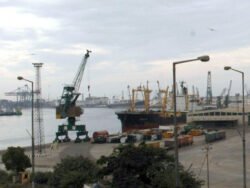Pakistan’s economic crossroads

17 May 2024
Published in: Business Recorder
The socialist idea of central planning, which leads to a closed economy, has been followed by neoliberalism and laissez-faire in the evolution of the global economy. Public-private partnerships (PPPs) are the most beneficial idea to have been devised yet, and many nations have chosen to privatise their state-owned businesses.
Economists who support capitalism, where the private sector assumes leadership and the state takes on the role of regulator, are the main owners and proponents of these ideas. The bigger and most crucial dilemma for nations like Pakistan is whether to pursue privatization or PPPs alone or combine the two in order to achieve economic progress.
In its 76-year existence, Pakistan has seen many fascinating events, such as the private sector taking the lead in growth, a push for nationalization, and the private sector eventually taking over development. While political parties had a significant role in the establishment of public-sector organizations (PSEs) for employment-related objectives, the private sector operated independently to get a considerable portion of its earnings via monopolization and cartelization.
In Pakistan, governmental institutions are involved in a mutually exclusive manner of operating that allows the public and private sectors to operate freely. However, the reality remains that Pakistan, despite its potential for rapid expansion and its potential to become an Asian tiger, has failed to live up to the hopes of its people.
Pakistan has had significant challenges in attaining strong development due to its mixed political system, given its predominant reliance on foreign loans, assistance, and support programmes from Western nations. As a consequence, the economy is heavily indebted, and the government is working non-stop to stabilize things. Pakistan finds itself in a precarious situation where it must make difficult choices in order to prevent default.
The PPP Chairman, Bilawal Bhutto-Zardari, has criticised the government’s plan to privatise PIA and other SOEs. Hence, there is criticism directed at the government’s desire to eliminate SOEs via privatization. He believes that rather than completely privatising, the government should pursue public-private partnerships. The issue still remains as to whether the approach — privatisation, hybrid mixes, or the PPP model—is the right one for Pakistan.
The hybrid model appears to be a promising solution. Pakistan can benefit from the government’s plan to privatize state-owned enterprises (SOEs) like PIA to eliminate financially unsound businesses. However, the risk of crony capitalism, which often underpins such privatization processes, looms large in countries like Pakistan. Allegations of selling PSEs like MCB to close friends and investors for personal gain were rampant during the final privatization phase of the first Nawaz Sharif regime.
It is a reality that wherever privatization occurs, particularly in developing nations, the governing class is invariably the target of similar accusations. However, given the weight of these accusations, it is crucial to take precautions against falsehoods. Transparency should be a hallmark of every process.
The private sector is thriving in the majority of industrialized nations, supporting economic growth and improving social indices. Their governments don’t operate the companies; instead, they serve as regulators. However, the situation is different in China. The economic growth model adopted by the Chinese government is a mixed one. It has chosen the PPP model for the majority of its business organizations, even though it allows the private sector to expand.
While owning the bulk of the shares, the government has floated share for private investors to invest in businesses and industries. Instead of being diminished, the state’s involvement in decision-making has been strengthened via a variety of consultative procedures. China’s economic improvement is impressive, making this a success story.
After eliminating its loss-making SOEs, Pakistan must embrace the PPP model for its future economic growth. The Public-Private Partnership Act, 2017 was previously enacted by the federal government, and after consultation, the cabinet has officially approved the PPP policy, also known as the P3 Policy. The government’s adoption of the PPP model and its intention to carry out development projects by enlisting the private sector under the PPP method is welcome news for Pakistanis.
Resources for the private sector to invest in should come from the government. In the oil and gas industry, where E&P businesses get concessions, we test this strategy. There is a win-win outcome here. Companies in the electricity industry can be another area of worry.
DISCOs have to operate in PPP mode. These electricity distribution firms have a great deal of financial potential. In order to finance further expansion, these businesses may offer their shares in P3 mode to individual investors. It’s conceivable that privatizing these businesses won’t be feasible or advantageous for our economy.
As seen in the instance of PTCL, private investors would be more than delighted to get shares and management. In order to attract further investment in this sector, the government should provide electricity distribution firms to potential investors. Pakistan can only adhere to the P3 model as an alternative.
By drawing foreign direct investment (FDI) into sectors such as mining, oil and gas, ports, aviation, agriculture, and minerals, Pakistan may develop significantly. In order to maintain economic stability, the SIFC (Special Investment Facilitation Council) is already aggressively pursuing these initiatives. In order to discuss B2B and G2G initiatives, Saudi investors have also travelled to Pakistan and met with representatives of the government and the commercial sector.
This is a positive beginning that will encourage investors and common Pakistanis to support further company growth. The government must prioritize this way of operating and making investments for future initiatives. The federal government must put the P3 policy into effect in its entirety. The PPP program is already being implemented by the provinces on a long-term basis.
Law and order, security, and investor trust are among the many challenges we face, all of which require immediate attention. In an environment of fear, anarchy, and uncertainty, no policy can thrive. The loss of faith in the system by many young people due to various circumstances underscores the need to rebuild people’s confidence and offer them hope for their future contributions. There’s never a perfect time to work here.
The government must step up its efforts to foster optimism and attract potential investors to Pakistan, emphasising the importance of these issues for the country’s economic progress.





